Warren Buffett’s 5-Year Test Is Key to Building Wealth

Warren Buffett is one of the most famous and popular investors of all time. The so-called “Oracle of Omaha” is one of the richest people in the world, with a reported current net worth of around $134 billion.
During his tenure as CEO of Berkshire Hathaway, the company’s average annual return has more than doubled that of the overall market, while its total return over the past 40 years simply dwarfs the S&P 500, at 50,799% vs. 4,213%. So, what is the key to Buffett’s success?
Read Next: Warren Buffett Sold His Apple Stock – Here’s Why
Learn More: 6 Genius Things All Wealthy People Do With Their Money
Among his many oft-quoted investment rules is the “5-year test.” Here’s an explanation of what it is, how it works and how you can use it to build your own wealth.
What Is the 5-Year Test?
Buffett’s 5-year test, also called the $1 test, is an analysis of how a company allocates its capital. In other words, Buffett wants to know if a company can generate shareholder value with its earnings over a moderately long period of time.
Specifically, in a 1996 booklet Buffett issued to his shareholders, he explained it like this, as referencing Berkshire Hathaway’s own performance:
“The five-year test should be: (1) during the period did our book-value gain exceed the performance of the S&P; and (2) did our stock consistently sell at a premium to book, meaning that every $1 of retained earnings was always worth more than $1? If these tests are met, retaining earnings has made sense.”
Retained earnings are essentially a company’s profit that it reinvests back into the business. So what Buffett is essentially saying in plain English is that for both his own company and for companies he invests in, he wants to see that the stock value exceeds the amount of earnings a company retains, or uses for its growth. If it fails to do so over a five-year period, then it’s not an attractive investment.
For You: I’m a Financial Advisor: These 5 Index Funds Are All You Really Need
How Does It Fit in With Buffett’s Overall Investment Philosophy?
Buffett is famous for investing for the long run, often saying that his favorite holding period is “forever.” The 5-year test makes sense in this overall philosophy, as it can only be used by long-term investors, not traders. Way back in his 1962 annual letter to partners in the Buffett Partnership, Buffett outlined the 5-year test in a bit more detail:
“While I much prefer a five-year test, I feel three years is an absolute minimum for judging performance. It is a certainty that we will have years when the partnership performance is poorer, perhaps substantially so, than the Dow. If any three-year or longer period produces poor results, we all should start looking around for other places to have our money. An exception to the latter statement would be three years covering a speculative explosion in a bull market.”
Buffett hedges his statement a bit in that last sentence, but with good reason. He’s making the point that during a market mania, such as during the dot-com bubble in 1999, it would be impossible for any company to keep up with the speculative and overpriced stocks of the time. But during periods of regular market activity, he adheres to the principles behind his test.
Are Buffett and Berkshire Hathaway Still Successful After All These Years?
Berkshire Hathaway has grown into the 7th-largest company in the entire S&P 500 index, with a massive market capitalization of $880 billion. By Buffett’s own admission, this limits the company in terms of market-beating performance, as there are only a small number of companies that it can invest in that will make any type of significant impact in terms of performance.
That being said, Berkshire somehow continues to shine. According to data from FactSet published in Forbes, here are the company’s returns over various periods compared with the S&P 500, as of Feb. 26, 2024:
YTD: Berkshire 18%, S&P 500 7%
12 months: Berkshire 37%, S&P 500 30%
5 years: Berkshire 110%, S&P 500 98%
10 years: Berkshire 271%, S&P 500 232%
20 years: Berkshire 570%, S&P 500 559%
30 years: Berkshire 4,102%, S&P 500 1,837%
40 years: Berkshire 50,799%, S&P 500 4,213%
How You Can Implement the 5-Year Test Into Your Own Investment Planning
Admittedly, the 5-year test involves a level of research and analysis that many investors aren’t willing to perform. But those who do will be utilizing a principle that has served one of the world’s richest people — and most successful investors — very well for many decades. In a world in which there’s an oversaturation of financial information and it can be hard to know what’s important to look at, Buffett’s test provides time-tested, hard data to use that can help point you in the right direction.
If you’d prefer not to dig this deep into company financial statements, Buffett has a solution for you also. As he told CNBC’s On The Money in 2017, “Consistently buy an S&P 500 low-cost index fund. I think it’s the thing that makes the most sense practically all of the time. Keep buying it through thick and thin, and especially through thin.”
More From GOBankingRates
This is One of the Best Ways to Boost Your Retirement Savings in 2024
6 Things You Should Never Do With Your Tax Refund (Do This Instead)
This article originally appeared on GOBankingRates.com: Warren Buffett’s 5-Year Test Is Key to Building Wealth
